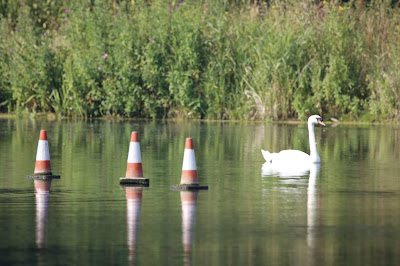Having exhausted a lot of the reserves in my usual area it was time to visit somewhere different and we entered unknown territory.
The first reserve of the day was Fingringhoe, just five miles out of Colchester. Its an old gravel workings completely grown over by scrub with good views of the Colne estuary courtesy of a load of hides. It is managed by the Essex Wildlife Trust (EWT), and was their first ever reserve.
Two months into a heat wave and the day was absolutely boiling - we were sweating buckets. This was a day with temperatures ranging over 30 degrees and we were feeling it. Vegetation was still green but everything was slowly dying off under the heat. As it was we saw very few small birds, and all the larger birds were present but mainly just sleeping, not wishing to exert any energy in this heat.
The reserve is a maze of footpaths, with many paths branching off going to areas you weren't sure were the right direction. However we walked a rough circle, starting along the side of the estuary before walking further inland to see the main part of the reserve.
The first hide gave great views over the estuary and a huge area of saltmarsh. The tide was high with many CURLEWS and GULLS roosting on the saltmarsh. On a scrape closer to the hide there was a flock of around forty GREENSHANK, mainly just sleeping, which made ID quite difficult, as they had no distinguishing plumage really.
Roosting GODWITS
Further hides over looked the estuary but provided little due to the high tide. Further along, the Kingfisher Hide overlooked a scrape where amongst roosting GODWITS and LAPWINGS there was a COMMON SAND and a LITTLE GREBE.The final hide overlooked an area that was once farmland but was allowed to be flooded by the neighbouring estuary over the past decade. When we visited it was high tide with WADERS roosting on the nearby bank, which was the old sea wall. Mainly GODWITS, there was a good variety of other birds as well. A few AVOCETS, around five SPOTSHANK, several GREY PLOVER, and singles of GOLDEN PLOVER and KNOT, the latter still in its brick red breeding plumage, looking very dapper.
On the way back we explored further into the reserve, and we disturbed something sunning itself on the path - an ADDER. Although it was only a brief view it was an unmistakable grey with black diamonds on its back, a real treat, I haven't seen one before this year.
In the centre of the reserve there is a small lake. On it there was an old brood of TUFTIES, a pair of TEAL and a single POCHARD.
We chilled at the centre for a while, surprised at how quiet the reserve was people wise. We still had a couple of hours left to beat rush hour traffic going through Colchester, so we decided on another reserve to visit.
Abbots Hall Farm
Maybe five miles away from Fingringhoe was Abbots Hall Farm, an EWT reserve, mainly working farmland where an area of land next to the estuary had been flooded, to turn farmland back to saltmarsh, which would have been its original habitat before human interference. It was one of the first attempts at this rewilding of its kind and has had around 16 years to form. This kind of habitat is what Hazelwood Marshes near Aldeburgh will eventually turn into (see other posts in my blog for details). It also forms the offices of the EWT.
Most of the reserve is farmland worked for wildlife, which meant smaller fields, more hedges and a greater diversity of crops than normal farmland. However considering how hot it was there were few birds about, with only a couple of BROWN HARES for company.
So with blistering heat and a rule which sees EWT reserves closing at five - which made us feel we were rushing things - we didn't have the best time. There was a problem with the hides in the fact they were badly sited and they didn't overlook anything. Seriously one hide overlooked a tiny stretch of river, and there was one hide which was on the map but didn't exist in reality.
It was interesting to see the reserve, as it was my first visit here, but I don't think I'll come back again. Too many reserves exist with birds often congregating at the best of them. In the end a farm is still a farm and doesn't provide anything that much different to my local patch. That's not taking away from the work the EWT does. I'm sure the farm is completely different to when they took over and wildlife has probably increased a lot since then. Its just not Minsmere.
Today was alright I guess, Fingringhoe was quite good, but there was nothing that really grabbed me today, something that would draw me back to this area in future. Maybe we should have gone to nearby Abberton Reservoir instead of Abbots Hall Farm, but with no real knowledge of the area it was difficult to really know what we would see around here, especially on a swelteringly hot day like today.






























